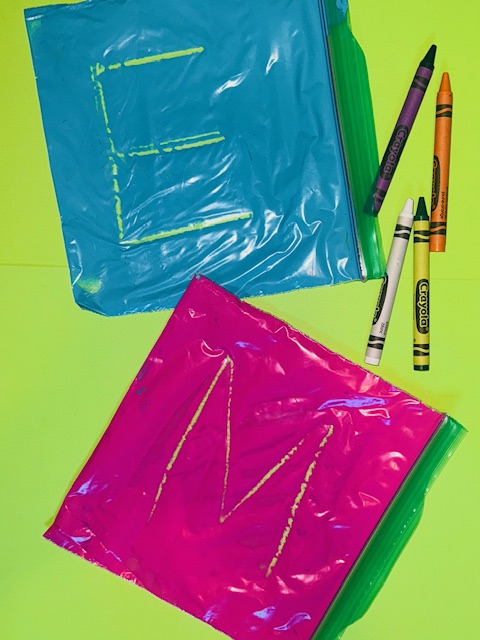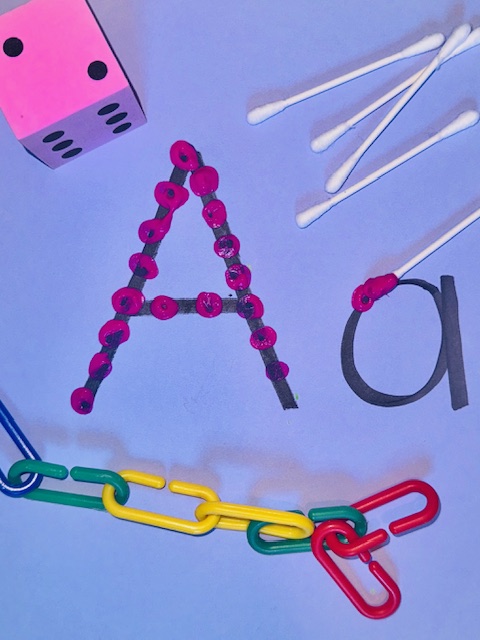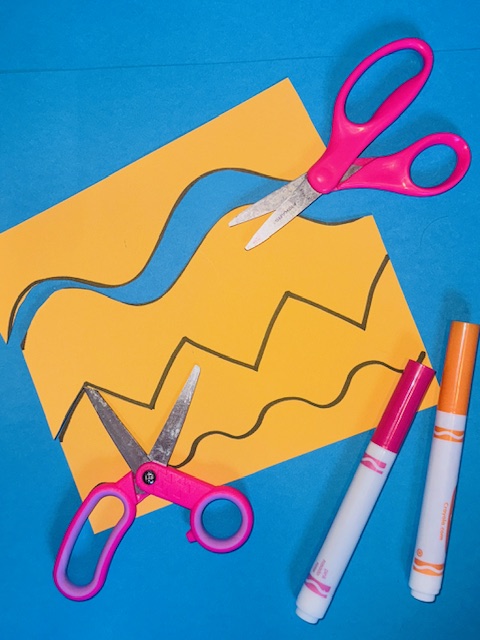Pre-writing activities for preschoolers not only help our youngest learners learn the shape and structure of the letters in the alphabet, they serve a number of other functions as well. According to education blogger Lisette from Where Imagination Grows, pre-writing practice teaches directionality in writing, encourages fine muscle development and coordination, and helps students process sensory information critical to the writing process.
Here are 28 super-fun, easy-to-make activities that your preschoolers will love!
1. Squishy Bags

All you need to make these awesome sensory bags is resealable zipper storage bags filled with a paste of flour, water, and food coloring. Zip the bags tight, then let kids use cotton swabs or their fingers to draw shapes, lines, and letters on the bag.
2. Bubble Wrap
What a great way to recycle all that leftover bubble wrap! Simply write letters on sheets of bubble wrap with a Sharpie. Then have kids trace them as they pop their way to letter recognition.
3. Play Dough Pancakes
Flatten out a medium-size ball of play dough like a pancake on a flat surface. Then use a sharp object to draw a letter on the flattened area. Make sure that the letter is large enough to be easily recognizable when filled with straws. Cut plastic straws into 1-inch segments. Then let kids “trace” the letters with the colorful straw segments.
4. Dot Markers
Students use dot markers to practice the mechanics of writing and get used to the angles and curves of letters. Download 12 free pages of pre-writing dot marker worksheets.
5. Play Dough Snakes

Kids can’t resist the sensory lure of play dough! For this activity, kids can roll small balls of dough into long snakes and form letters by bending and joining the snakes together. To help guide their work, provide letter cards.
6. LEGO Blocks
Blocks! Young kids can’t get enough of building and creating with them. Put their creative energy to good use by having them build letters on letter cards.
7. Beads
This activity builds fine motor skills that your young students need to begin writing. Students use inexpensive pony beads (found at any craft store) to follow pre-printed lines.
Another fun way to use pony beads: Draw a letter in play dough and let students trace the letter by lining up pony beads along the outline.
8. Sand Tray
One of the simplest pre-writing activities to put together for your preschoolers is a sand tray. Kids can use their fingers or an unsharpened pencil to practice writing. As an alternative to sand, you can fill your tray with salt, flour, cornmeal, or rice.
9. Squeeze Bottle
For this easy-to-prepare activity, simply fill a plastic squeeze bottle with salt or sugar and let students trace letters on cards by squeezing the bottle.
10. Cotton Swabs and Paint

This is a fun activity to help kids work on their fine motor skills and get the hang of the all-important pencil grip. Show kids how to properly hold the swab like a pencil, then dip the swab in the paint and practice writing on paper. Check back and make adjustments to their grip.
11. Glitter Glue
Pre-writing lines are important building blocks for any preschooler to master before learning letter formations. Download this glitter glue pre-writing line practice for preschoolers activity.
12. Rainbow Tray
This resource is so simple to make, and kids love it! Simply tape colored tissue paper in a rainbow pattern to the bottom of a clear plastic tray. Fill it with sand, and as the kids trace lines and letters, the colors below are revealed. For extra fun, place the tray on top of a light table to add a glowing dimension to the rainbow.
13. Masking Tape
This is a fun center activity for learning letters. Provide students with a roll of colored masking tape and a clear surface, like a mirror, window, or table. Then have them tear off sections of tape to form letters.
14. Magnet Board
Write letters on a magnet board with a dry-erase marker and let your little ones trace them with magnets. Or make letters with masking tape and draw a dotted line down the middle, creating a “road.” Then students can “drive” car magnets along the letter road.
15. Lacing Cards
Grasping a string between tiny fingers and threading the end through the holes in a lacing card is great fine motor practice for preschoolers. It also begins to build muscle memory for holding a pencil properly. Create your own lacing cards with card stock and a hole punch.
16. Shaving Cream

This classic activity is a great starting place for pre-writers. All you need is a tray and a can of shaving cream. Then, students can use a stick, a swab, or their finger as they write letters, shapes, or words.
17. Buttons
Preschoolers will have so much fun creating patterns, swirls, squiggles, and zigzags with colorful buttons. And they’ll be building fine motor skills while they’re at it!
18. Sticker Line-Up
Preschoolers need to use a pinching motion, which builds hand strength, to peel sticker dots off the page. Then, they use hand-eye coordination to place each sticker along a drawn line. This activity would be perfect for a writing or free-time station.
19. Fingerprint Writing
Some kids don’t like to get their fingers this messy, but others adore it! For this activity, you will need poster paper and a palette of washable ink. Draw letters, shapes, and lines on a clean piece of paper. Then, show kids how to dip their pointer finger onto the ink pad and follow the lines dot by dot.
20. Clothespin Clipping
Using a clothespin requires grip strength. Any activity that involves clipping clothespins will help kids build the fine motor skills required for writing.
21. Using Scissors

Cutting and snipping activities with scissors are excellent ways for children to practice fine motor skills and control. Give your students lots of opportunities to practice their cutting skills with paper, string, card stock, and even snakes of Play-Doh!
22. Scrunching Paper
Scrunching paper into a ball is great for building hand strength. Let your preschoolers use computer paper, newspaper, tissue paper, or wrapping paper to create a tight ball. Then play a game of paper ball tag!
23. Ice Painting
As young learners grasp a paintbrush and apply paint onto melting ice, they’re building fine motor skills. This helps develop hand-eye coordination and strengthens the muscles in their hands and fingers.
24. Alphabet Stamps

Preschoolers enjoy tactile fun and learning while building small motor skills with these dough stampers. Sturdy alphabet stamps can be pushed into soft play dough or clay. Includes all 26 letters.
Buy it: Dough Stampers
25. Paint With Water (or Chalk)
Take your preschoolers outside and let them loose on the sidewalk with a cup of water and a paintbrush. Let them draw squiggles, lines, letters, etc. All of these options reinforce writing skills. Alternatively, let students use colored chalk.
26. Pipe Cleaners
Pipe cleaners can be used for a variety of pre-writing activities to help preschoolers develop their finger muscles and fine motor skills. Make shapes, add beads, curl them around pencils, and more!
27. Scribble
Scribbling does wonders for teaching preschoolers how to apply the right amount of pressure to, and control the movement of, crayons and pencils in order to make them work. And not only that, it’s fun! Use poster paper or cardboard boxes to make it a group project.
28. Finger Tracing
Learning to write with a pencil is important, but for learning letters, fingers can work just as well. Prepare letter cards and demonstrate where to begin. The more students practice, the greater the muscle memory.

